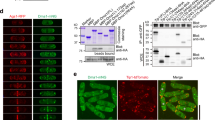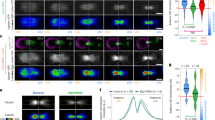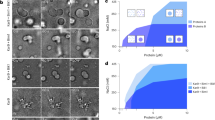Abstract
Microtubules are central to eukaryotic cell morphogenesis. Microtubule plus-end tracking proteins (+TIPs) transport polarity factors to the cell cortex, thereby playing a key role in both microtubule dynamics and cell polarity. However, the signalling pathway linking +TIPs to cell polarity control remains elusive. Here we show that the fission yeast checkpoint kinase Cds1 (Chk2 homologue) delays the transition of growth polarity from monopolar to bipolar (termed NETO; new-end take-off). The +TIPs CLIP170 homologue Tip1 and kinesin Tea2 are responsible for this delay, which is accompanied by a reduction in microtubule dynamics at the cell tip. Remarkably, microtubule stabilization occurs asymmetrically, prominently at the non-growing cell end, which induces abnormal accumulation of the polarity factor Tea1. Importantly, NETO delay requires activation of calcineurin, which is carried out by Cds1, resulting in Tip1 dephosphorylation. Thus, our study establishes a critical link between calcineurin and checkpoint-dependent cell morphogenesis.
This is a preview of subscription content, access via your institution
Access options
Subscribe to this journal
Receive 12 print issues and online access
$209.00 per year
only $17.42 per issue
Buy this article
- Purchase on Springer Link
- Instant access to full article PDF
Prices may be subject to local taxes which are calculated during checkout







Similar content being viewed by others
References
Drubin, D. G. & Nelson, W. J. Origins of cell polarity. Cell 84, 335–344 (1996).
Hayles, J. & Nurse, P. A journey into space. Nat. Rev. Mol. Cell Biol. 2, 647–656 (2001).
Li, R. & Gundersen, G. G. Beyond polymer polarity: how the cytoskeleton builds a polarized cell. Nat. Rev. Mol. Cell Biol. 9, 860–873 (2008).
Akhmanova, A. & Steinmetz, M. O. Tracking the ends: a dynamic protein network controls the fate of microtubule tips. Nat. Rev. Mol. Cell Biol. 9, 309–322 (2008).
Busch, K. E. & Brunner, D. The microtubule plus end-tracking proteins mal3p and tip1p cooperate for cell-end targeting of interphase microtubules. Curr. Biol. 14, 548–559 (2004).
Brunner, D. & Nurse, P. CLIP170-like tip1p spatially organizes microtubular dynamics in fission yeast. Cell 102, 695–704 (2000).
Browning, H. et al. Tea2p is a kinesin-like protein required to generate polarized growth in fission yeast. J. Cell Biol. 151, 15–27 (2000).
Browning, H., Hackney, D. D. & Nurse, P. Targeted movement of cell end factors in fission yeast. Nat. Cell Biol. 5, 812–818 (2003).
Bieling, P. et al. Reconstitution of a microtubule plus-end tracking system in vitro. Nature 450, 1100–1105 (2007).
Mata, J. & Nurse, P. tea1 and the microtubular cytoskeleton are important for generating global spatial order within the fission yeast cell. Cell 89, 939–949 (1997).
Martin, S. G., McDonald, W. H., Yates, J. R. III & Chang, F. Tea4p links microtubule plus ends with the formin For3p in the establishment of cell polarity. Dev. Cell 8, 479–491 (2005).
Tatebe, H., Shimada, K., Uzawa, S., Morigasaki, S. & Shiozaki, K. Wsh3/Tea4 is a novel cell-end factor essential for bipolar distribution of Tea1 and protects cell polarity under environmental stress in S. pombe. Curr. Biol. 15, 1006–1015 (2005).
Mitchison, J. M. & Nurse, P. Growth in cell length in the fission yeast Schizosaccharomyces pombe. J. Cell Sci. 75, 357–376 (1985).
Martin, S. G. Microtubule-dependent cell morphologenesis in the fission yeast. Trends Cell Biol. 19, 447–454 (2009).
Rhind, N. & Russell, P. Chk1 and Cds1: linchpins of the DNA damage and replication checkpoint pathways. J. Cell Sci. 113, 3889–3896 (2000).
O’Connell, M. J., Walworth, N. C. & Carr, A. M. The G2-phase DNA-damage checkpoint. Trends Cell Biol. 10, 296–303 (2000).
D’Urso, G., Grallert, B. & Nurse, P. DNA polymerase alpha, a component of the replication initiation complex, is essential for the checkpoint coupling S phase to mitosis in fission yeast. J. Cell Sci. 108, 3109–3118 (1995).
Lindsay, H. D. et al. S-phase-specific activation of Cds1 kinase defines a subpathway of the checkpoint response in Schizosaccharomyces pombe. Genes Dev. 12, 382–395 (1998).
Rupes, I., Jia, Z. & Young, P. G. Ssp1 promotes actin depolymerization and is involved in stress response and new end take-off control in fission yeast. Mol. Biol. Cell 10, 1495–1510 (1999).
Snaith, H. A. & Sawin, K. E. Fission yeast mod5p regulates polarized growth through anchoring of tea1p at cell tips. Nature 423, 647–651 (2003).
Martin-Garcia, R. & Mulvihill, D. P. Myosin V spatially regulates microtubule dynamics and promotes the ubiquitin-dependent degradation of the fission yeast CLIP-170 homologue, Tip1. J. Cell Sci. 122, 3862–3872 (2009).
Klee, C. B., Ren, H. & Wang, X. Regulation of the calmodulin-stimulated protein phosphatase, calcineurin. J. Biol. Chem. 273, 13367–13370 (1998).
Yoshida, T., Toda, T. & Yanagida, M. A calcineurin-like gene ppb1+ in fission yeast: mutant defects in cytokinesis, cell polarity, mating and spindle pole body positioning. J. Cell Sci. 107, 1725–1735 (1994).
Deng, L. et al. Real-time monitoring of calcineurin activity in living cells: evidence for two distinct Ca2+-dependent pathways in fission yeast. Mol. Biol. Cell 17, 4790–4800 (2006).
Stathopoulos, A. M. & Cyert, M. S. Calcineurin acts through the CRZ1/TCN1-encoded transcription factor to regulate gene expression in yeast. Genes Dev. 11, 3432–3444 (1997).
Aramburu, J. et al. Selective inhibition of NFAT activation by a peptide spanning the calcineurin targeting site of NFAT. Mol. Cell 1, 627–637 (1998).
Roy, J., Li, H., Hogan, P. G. & Cyert, M. S. A conserved docking site modulates substrate affinity for calcineurin, signalling output, and in vivo function. Mol. Cell 25, 889–901 (2007).
Seet, B. T., Dikic, I., Zhou, M. M. & Pawson, T. Reading protein modifications with interaction domains. Nat. Rev. Mol. Cell Biol. 7, 473–483 (2006).
O’Neill, T. et al. Determination of substrate motifs for human Chk1 and hCds1/Chk2 by the oriented peptide library approach. J. Biol. Chem. 277, 16102–16115 (2002).
Wilson-Grady, J. T., Villen, J. & Gygi, S. P. Phosphoproteome analysis of fission yeast. J. Proteome Res. 7, 1088–1097 (2008).
Antoni, L., Sodha, N., Collins, I. & Garrett, M. D. CHK2 kinase: cancer susceptibility and cancer therapy—two sides of the same coin? Nat. Rev. Cancer 7, 925–936 (2007).
Nishiyama, T., Yoshizaki, N., Kishimoto, T. & Ohsumi, K. Transient activation of calcineurin is essential to initiate embryonic development in Xenopus laevis. Nature 449, 341–345 (2007).
Baek, K. H. et al. Down’s syndrome suppression of tumour growth and the role of the calcineurin inhibitor DSCR1. Nature 459, 1126–1130 (2009).
Jordan, M. A. & Wilson, L. Microtubules as a target for anticancer drugs. Nat. Rev. Cancer 4, 253–265 (2004).
Dantal, J. & Soulillou, J. P. Immunosuppressive drugs and the risk of cancer after organ transplantation. N. Engl. J. Med. 352, 1371–1373 (2005).
West, R. R., Vaisberg, E. V., Ding, R., Nurse, P. & McIntosh, J. R. cut11+: a gene required for cell cycle-dependent spindle pole body anchoring in the nuclear envelope and bipolar spindle formation in Schizosaccharomyces pombe. Mol. Biol. Cell 9, 2839–2855 (1998).
Moreno, S., Klar, A. & Nurse, P. Molecular genetic analysis of fission yeast Schizosaccharomyces pombe. Methods Enzymol. 194, 795–823 (1991).
Damagnez, V., Tillit, J., de Recondo, A-M. & Baldacci, G. The POL1 gene from the fission yeast, Schizosaccharomyces pombe, shows conserved amino acid blocks specific for eukaryotic DNA polymerases alpha. Mol. Gen. Genet. 226, 182–189 (1991).
Bähler, J. et al. Heterologous modules for efficient and versatile PCR-based gene targeting in Schizosaccharomyces pombe. Yeast 14, 943–951 (1998).
Keeney, J. B. & Boeke, J. D. Efficient targeted integration at leu1-32 and ura4-294 in Schizosaccharomyces pombe. Genetics 136, 849–856 (1994).
Bähler, J. & Nurse, P. Fission yeast Pom1p kinase activity is cell cycle regulated and essential for cellular symmetry during growth and division. EMBO J. 20, 1064–1073 (2001).
Kinoshita, E., Kinoshita-Kikuta, E., Takiyama, K. & Koike, T. Phosphate-binding tag, a new tool to visualize phosphorylated proteins. Mol. Cell. Proteomics 5, 749–757 (2006).
Smith, C. L. et al. An electrophoretic karyotype for Schizosaccharomyces pombe by pulsed field gel electrophoresis. Nucleic Acids Res. 15, 4481–4489 (1987).
Acknowledgements
We thank D. Brunner, K. Kitamura, H. Murakami and P. Russell for strains and plasmids; K. Gull for antibody; E. Kinoshita for Phos-tag; Astellas Pharma for providing FK506; and all members of our laboratory for their help. We also thank D. Brunner, S. Martin, D. McCollum, K. Sawin, M. Yanagida and J. Hirata for discussions; and H. Iefuji, K. Ono, T. Miyakawa and K. Hirata for their support. This work was supported by grants from the Ministry of Education, Science, and Culture of Japan (to K.K. and D.H.), and by Cancer Research UK (to T.T.)
Author information
Authors and Affiliations
Contributions
Experimental design and interpretation of data were conducted by all authors. K.K., T.K. and M.K. carried out experiments. K.K. and D.H. planned the project and D.H. wrote the paper with input from the co-authors. T.T. reviewed the manuscript.
Corresponding author
Ethics declarations
Competing interests
The authors declare no competing financial interests.
Supplementary information
Supplementary Information
Supplementary Information (PDF 1600 kb)
Supplementary Table
Supplementary Information (XLS 133 kb)
Rights and permissions
About this article
Cite this article
Kume, K., Koyano, T., Kanai, M. et al. Calcineurin ensures a link between the DNA replication checkpoint and microtubule-dependent polarized growth. Nat Cell Biol 13, 234–242 (2011). https://doi.org/10.1038/ncb2166
Received:
Accepted:
Published:
Issue Date:
DOI: https://doi.org/10.1038/ncb2166
This article is cited by
-
Ubiquitination of CLIP-170 family protein restrains polarized growth upon DNA replication stress
Nature Communications (2022)
-
Calcineurin-Mediated Regulation of Hyphal Growth, Septation, and Virulence in Aspergillus fumigatus
Mycopathologia (2014)
-
Conserved rules govern genetic interaction degree across species
Genome Biology (2012)



